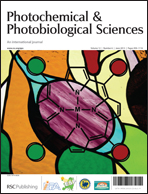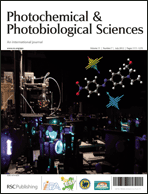For Photochemical & Photobiological Sciences, the top 10 most accessed articles in February were as follows:
Signaling mechanisms of LOV domains: new insights from molecular dynamics studies
Peter L. Freddolino, Kevin H. Gardner and Klaus Schulten
Photochem. Photobiol. Sci., 2013, Advance Article
DOI: 10.1039/C3PP25400C, Paper
UV-induced DNA damage and repair: a review
Rajeshwar P. Sinha and Donat-P. Häder
Photochem. Photobiol. Sci., 2002, 1, 225-236
DOI: 10.1039/B201230H, Perspective
Photochemical properties of multi-azobenzene compounds
Julia Bahrenburg, Claudia M. Sievers, Jan Boyke Schönborn, Bernd Hartke, Falk Renth, Friedrich Temps, Christian Näther and Frank D. Sönnichsen
Photochem. Photobiol. Sci., 2013, 12, 511-518
DOI: 10.1039/C2PP25291K, Paper
UV–vis spectroscopy of the coupling products of the palladium-catalyzed C–H arylation of the BODIPY core
Lina Wang, Bram Verbelen, Claire Tonnelé, David Beljonne, Roberto Lazzaroni, Volker Leen, Wim Dehaen and Noël Boens
Photochem. Photobiol. Sci., 2013, 12, 835-847
DOI: 10.1039/C3PP25385F, Paper
The Orange Carotenoid Protein: a blue-green light photoactive protein
Diana Kirilovsky and Cheryl A. Kerfeld
Photochem. Photobiol. Sci., 2013, Advance Article
DOI: 10.1039/C3PP25406B, Perspective
Targeted photodynamic therapy of breast cancer cells using antibody–phthalocyanine–gold nanoparticle conjugates
Tanya Stuchinskaya, Miguel Moreno, Michael J. Cook, Dylan R. Edwards and David A. Russell
Photochem. Photobiol. Sci., 2011, 10, 822-831
DOI: 10.1039/C1PP05014A, Paper
Human safety review of “nano” titanium dioxide and zinc oxide
Karsten Schilling, Bobbie Bradford, Dominique Castelli, Eric Dufour, J. Frank Nash, Wolfgang Pape, Stefan Schulte, Ian Tooley, Jeroen van den Bosch and Florian Schellauf
Photochem. Photobiol. Sci., 2010, 9, 495-509
DOI: 10.1039/B9PP00180H, Perspective
Effects of bis-carbazole based D–π-A sensitizers on solar energy capture in DSSCs
Bo Hyung Kim and Harold S. Freeman
Photochem. Photobiol. Sci., 2013, 12, 421-431
DOI: 10.1039/C2PP25262G, Paper
Ozone depletion and climate change: impacts on UV radiation
R. L. McKenzie, P. J. Aucamp, A. F. Bais, L. O. Björn, M. Ilyas and S. Madronich
Photochem. Photobiol. Sci., 2011, 10, 182-198
DOI: 10.1039/C0PP90034F, Perspective
Engineered photoreceptors as novel optogenetic tools
Andreas Möglich and Keith Moffat
Photochem. Photobiol. Sci., 2010, 9, 1286-1300
DOI: 10.1039/C0PP00167H, Perspective
Take a look at the articles, and then let us know your thoughts and comments below.
Fancy submitting your own work to Phochemical & Photobiological Sciences? You can submit online today, or email us with your ideas and suggestions.
 The front cover this month features work by Mathias O. Senge and co-workers from Dublin, Ireland. In their work, the authors describe how 5,10-A2B2 porphyrins provide diverse nonlinear absorptive responses in the ns regime at 532 nm depending on the structural features.
The front cover this month features work by Mathias O. Senge and co-workers from Dublin, Ireland. In their work, the authors describe how 5,10-A2B2 porphyrins provide diverse nonlinear absorptive responses in the ns regime at 532 nm depending on the structural features.











